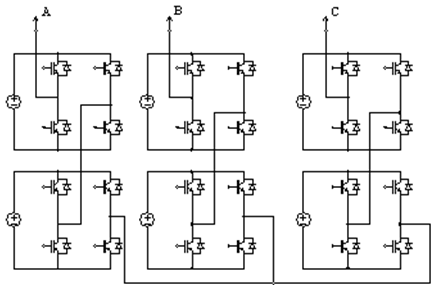Power quality enhancement using active power filter five-level cascade H-bridge under unbalanced and distorted grid
DOI:
https://doi.org/10.20998/2074-272X.2023.1.03Keywords:
multilevel active power filter, total harmonic distortion, instantaneous active and reactive power, harmonic currents, synchronous reference frame theoryAbstract
Introduction. To improve the power quality of a supply system, the total harmonic distortion (THD) is the most important parameter in the quantification of harmonics caused by nonlinear loads. In practice, it must be less than 5 %. The novelty of the proposed work consists in the use of a cascaded five level active filter, when the converter consisting of six H-bridge pairs, each one includes four transistors. Purpose. To increase the efficiency of this filter, two techniques for quantification of harmonic currents are proposed, first the PQ-theory which is simple but can only be used in case of a balanced grid, and second the synchronous reference frame theory (SFR-theory), which is capable of creating harmonic current not only in an unbalanced grid, but also in an unbalanced and distorted beam. Methods. Using the control techniques, the harmonic current is extracted from load current and considered as a reference. The constructed current should follow this reference. Results. The estimation of the active and reactive powers is based on the measurement of the currents crossing the load and the network voltages, these powers are used to determine the shape of the harmonic (reference) current. Using the PI regulator, the output current of the five-level inverter follows the reference current perfectly. The inverters output current is injected into the grid to eliminate harmonic currents. Practical value. In practice, the harmonic distortion rate THD is the most widely used criterion for criticizing the waveform of the currents and judging the quality of the energy involved. For currents on the source side, the THD is considered acceptable if it is less than 5 %, in our proposal the THD is 0.85 % with the PQ-theory and 2.34 % with SFR-theory, so it is optimal.
References
Sanjan P.S., Gowtham N., Bhaskar M.S., Subramaniam U., Almakhles D.J., Padmanaban S., Yamini N.G. Enhancement of Power Quality in Domestic Loads Using Harmonic Filters. IEEE Access, 2020, vol. 8, pp. 197730-197744. doi: https://doi.org/10.1109/ACCESS.2020.3034734.
Das S.R., Ray P.K., Sahoo A.K., Ramasubbareddy S., Babu T.S., Kumar N.M., Elavarasan R.M., Mihet-Popa L. A Comprehensive Survey on Different Control Strategies and Applications of Active Power Filters for Power Quality Improvement. Energies, 2021, vol. 14, no. 15, art. no. 4589. doi: https://doi.org/10.3390/en14154589.
Fujita H., Akagi H. A practical approach to harmonic compensation in power systems-series connection of passive and active filters. IEEE Transactions on Industry Applications, 1991, vol. 27, no. 6, pp. 1020-1025. doi: https://doi.org/10.1109/28.108451.
Karuppanan P., Mahapatra K. A novel SRF based cascaded multilevel active filter for power line conditioners. 2010 Annual IEEE India Conference (INDICON), 2010, pp. 1-4. doi: https://doi.org/10.1109/INDCON.2010.5712667.
Colak I., Kabalci E., Bayindir R. Review of multilevel voltage source inverter topologies and control schemes. Energy Conversion and Management, 2011, vol. 52, no. 2, pp. 1114-1128. doi: https://doi.org/10.1016/j.enconman.2010.09.006.
Barkati S., Baghli L., Berkouk E.M., Boucherit M.-S. Harmonic elimination in diode-clamped multilevel inverter using evolutionary algorithms. Electric Power Systems Research, 2008, vol. 78, no. 10, pp. 1736-1746. doi: https://doi.org/10.1016/j.epsr.2008.03.010.
Yin X., Yi H., Yang Z., Zhuo F. Global Configuration Strategy of SAPFs Combined with Comprehensive Evaluation of Power Quality in Distribution Network. 2022 International Conference on Power Energy Systems and Applications (ICoPESA), 2022, pp. 430-436. doi: https://doi.org/10.1109/ICoPESA54515.2022.9754415.
Seung-Gi Jeong, Myung-Ho Woo. DSP-based active power filter with predictive current control. IEEE Transactions on Industrial Electronics, 1997, vol. 44, no. 3, pp. 329-336. doi: https://doi.org/10.1109/41.585830.
Buso S., Malesani L., Mattavelli P. Comparison of current control techniques for active filter applications. IEEE Transactions on Industrial Electronics, 1998, vol. 45, no. 5, pp. 722-729. doi: https://doi.org/10.1109/41.720328.
Afonso J., Couto C., Martins J. Active Filters with Control Based on the p-q Theory. IEEE Industrial Electronics Society Newsletter, 2000, vol. 47, no. 3, pp. 5-10. Available at: https://hdl.handle.net/1822/1921 (Accessed 26 April 2022).
Kalkoul S., Benalla H., Nabti K., Abdellatif R. An adaptive harmonic compensation strategy for three-phase shunt active power filter based on double second-order generalized integrator with prefilter. Electrical Engineering & Electromechanics, 2020, no. 3, pp. 58-64. doi: https://doi.org/10.20998/2074-272X.2020.3.09.

Downloads
Published
How to Cite
Issue
Section
License
Copyright (c) 2022 M. Guergah, K. Nebti, S. E. Rezgui, H. Benalla, D. Ould-Abdeslam

This work is licensed under a Creative Commons Attribution-NonCommercial 4.0 International License.
Authors who publish with this journal agree to the following terms:
1. Authors retain copyright and grant the journal right of first publication with the work simultaneously licensed under a Creative Commons Attribution License that allows others to share the work with an acknowledgement of the work's authorship and initial publication in this journal.
2. Authors are able to enter into separate, additional contractual arrangements for the non-exclusive distribution of the journal's published version of the work (e.g., post it to an institutional repository or publish it in a book), with an acknowledgement of its initial publication in this journal.
3. Authors are permitted and encouraged to post their work online (e.g., in institutional repositories or on their website) prior to and during the submission process, as it can lead to productive exchanges, as well as earlier and greater citation of published work.




